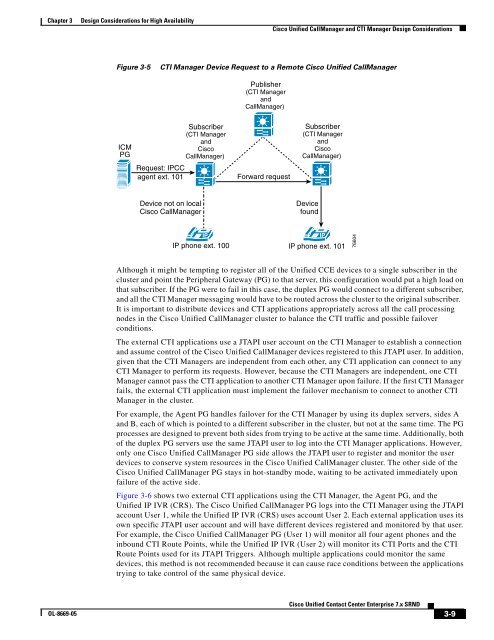Cisco Unified Contact Center Enterprise Solution Reference ...
Cisco Unified Contact Center Enterprise Solution Reference ...
Cisco Unified Contact Center Enterprise Solution Reference ...
You also want an ePaper? Increase the reach of your titles
YUMPU automatically turns print PDFs into web optimized ePapers that Google loves.
Chapter 3 Design Considerations for High Availability<br />
OL-8669-05<br />
<strong>Cisco</strong> <strong>Unified</strong> CallManager and CTI Manager Design Considerations<br />
Figure 3-5 CTI Manager Device Request to a Remote <strong>Cisco</strong> <strong>Unified</strong> CallManager<br />
ICM<br />
PG<br />
Subscriber<br />
(CTI Manager<br />
and<br />
<strong>Cisco</strong><br />
CallManager)<br />
Request: IPCC<br />
agent ext. 101<br />
Device not on local<br />
<strong>Cisco</strong> CallManager<br />
Publisher<br />
(CTI Manager<br />
and<br />
CallManager)<br />
Forward request<br />
Subscriber<br />
(CTI Manager<br />
and<br />
<strong>Cisco</strong><br />
CallManager)<br />
Device<br />
found<br />
IP IP<br />
IP phone ext. 100<br />
IP phone ext. 101<br />
Although it might be tempting to register all of the <strong>Unified</strong> CCE devices to a single subscriber in the<br />
cluster and point the Peripheral Gateway (PG) to that server, this configuration would put a high load on<br />
that subscriber. If the PG were to fail in this case, the duplex PG would connect to a different subscriber,<br />
and all the CTI Manager messaging would have to be routed across the cluster to the original subscriber.<br />
It is important to distribute devices and CTI applications appropriately across all the call processing<br />
nodes in the <strong>Cisco</strong> <strong>Unified</strong> CallManager cluster to balance the CTI traffic and possible failover<br />
conditions.<br />
The external CTI applications use a JTAPI user account on the CTI Manager to establish a connection<br />
and assume control of the <strong>Cisco</strong> <strong>Unified</strong> CallManager devices registered to this JTAPI user. In addition,<br />
given that the CTI Managers are independent from each other, any CTI application can connect to any<br />
CTI Manager to perform its requests. However, because the CTI Managers are independent, one CTI<br />
Manager cannot pass the CTI application to another CTI Manager upon failure. If the first CTI Manager<br />
fails, the external CTI application must implement the failover mechanism to connect to another CTI<br />
Manager in the cluster.<br />
For example, the Agent PG handles failover for the CTI Manager by using its duplex servers, sides A<br />
and B, each of which is pointed to a different subscriber in the cluster, but not at the same time. The PG<br />
processes are designed to prevent both sides from trying to be active at the same time. Additionally, both<br />
of the duplex PG servers use the same JTAPI user to log into the CTI Manager applications. However,<br />
only one <strong>Cisco</strong> <strong>Unified</strong> CallManager PG side allows the JTAPI user to register and monitor the user<br />
devices to conserve system resources in the <strong>Cisco</strong> <strong>Unified</strong> CallManager cluster. The other side of the<br />
<strong>Cisco</strong> <strong>Unified</strong> CallManager PG stays in hot-standby mode, waiting to be activated immediately upon<br />
failure of the active side.<br />
Figure 3-6 shows two external CTI applications using the CTI Manager, the Agent PG, and the<br />
<strong>Unified</strong> IP IVR (CRS). The <strong>Cisco</strong> <strong>Unified</strong> CallManager PG logs into the CTI Manager using the JTAPI<br />
account User 1, while the <strong>Unified</strong> IP IVR (CRS) uses account User 2. Each external application uses its<br />
own specific JTAPI user account and will have different devices registered and monitored by that user.<br />
For example, the <strong>Cisco</strong> <strong>Unified</strong> CallManager PG (User 1) will monitor all four agent phones and the<br />
inbound CTI Route Points, while the <strong>Unified</strong> IP IVR (User 2) will monitor its CTI Ports and the CTI<br />
Route Points used for its JTAPI Triggers. Although multiple applications could monitor the same<br />
devices, this method is not recommended because it can cause race conditions between the applications<br />
trying to take control of the same physical device.<br />
76604<br />
<strong>Cisco</strong> <strong>Unified</strong> <strong>Contact</strong> <strong>Center</strong> <strong>Enterprise</strong> 7.x SRND<br />
3-9
















